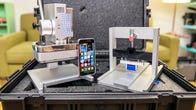The Self Service Repair program Apple launched in April is expanding beyond iPhones to include M1-based Apple MacBook Air and MacBook Pro laptops.
Starting on Tuesday you — or a host of service centers, if you’re not comfortable — will be able to find a repair manual, buy select components from Apple, swap them out for replacements and return the old components to Apple, in many cases for credit.
The company plans to add more Macs to the roster later this year.
For all the models supported by this initial rollout — the 2020 M1 MacBook Air and 13-inch MacBook Pro and the 2021 14-inch MacBook Pro and 16-inch MBP — Apple allows you to replace about 15 different components. They include the audio subsystem, battery, display, logic board, case top and bottom, antennas, keycaps (plus Touch ID circuit board) and more.
The move is unsurprising: Apple had said it would be ramping up to more products over the course of the year. And it makes sense given that right-to-repair laws (which essentially hold that companies can’t prevent you or an independent shop from repairing electronics by withholding information, voiding warranties and so on) have been passing in the US, such as New York’s recent Digital Fair Repair Act.
There will also be rental toolkits for each model at $49 for a week if you don’t have or want to buy new tools for the job.
Note that many of the drawbacks to the repair program that iFixit called out for the iPhone apply to the MacBooks as well, notably that it doesn’t extend to older devices — you know, the ones that really need it. Apple says it has no plans to expand to include Intel models. Newer M2 models, however, will eventually be added, as will the M1 iMac desktop.
It’s great that Apple has started opening its products up to a broader number of consumer and service center repairs. But being able to upgrade or replace typical modular components like memory and storage without having to swap the entire logic board, at least in the higher-end MacBook Pros, would be great and possibly more environmentally responsible. That issue isn’t specific to Apple, though. Even simply improving the reparability would help.





